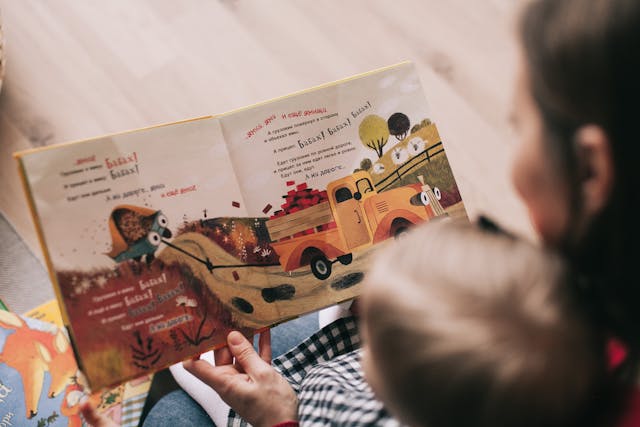Most people will agree that reading books is beneficial for you. You spend time in a quality way; you learn, you entertain, you develop. But that’s usually something that people do when they’re older; not when you’re still a child playing with toy cars, dolls, and Legos.

So, is there a way to inspire your kids’ love/interest for books? Well, it’s in the title; what you need is storytelling. Storytelling is a powerful way to stimulate children’s imagination and make them fall in love with books and reading from a young age.
If you’re creative and you turn reading stories into a fun activity, it‘ll be even easier for children to acquire new knowledge and skills. In addition, this activity is also great for acquiring/managing a child’s bedtime routine.
Why Storytelling is Important in the Early Childhood Development?
As children are introduced to new and different characters, events and words, they are also expanding their “little world” via imagination/creativity.
This way, they learn to solve problems or even understand emotions that they have not experienced before.
They will probably ask you more and more follow-up questions over time, which will only show their progress. Children are curious, so you must “feed” their brains with quality information. And what is a better way to do that than through games?
The scholastic kids & family reading report shows that storytelling and frequent reading activities are linked to cognitive growth. It emphasizes that frequent readers (5-7 days a week) show stronger cognitive skills and creativity compared to infrequent readers.
3 Creative Storytelling Activities to Try at Home
You don’t need any special tools and materials for these activities, only the most precious thing – spending time with your child. Ok, and maybe some glitter.
- Create a DIY Storybook
Have you already read all the stories you have, or is your child asking for more? Maybe you just want something different? This is the most creative way to bring your child closer to storytelling and encourage creativity development.
For this purpose, gather sheets of white paper, crayons, markers, or any other coloring materials that a kid enjoys. If the child is smaller, they can perhaps tell a story based on a picture book, since drawings/illustrations are usually understood way before written words are; plus, doing more mechanically-challenging tasks might be too much at that stage of the child’s life (you know your child best, so you decide on that! :)).
This approach is nice because it can be every time a different story. And when the kid has already learnt how to write, they can compose their very own children’s book.
If they enjoy it, it can become a regular weekly activity. This encourages the development of imagination, drawing, and writing, as well as the connection of events as a whole.
- Storytelling Through Role Play
Children’s home theater? Why not. Children like to pretend that they are characters from a fairy tale. Let them choose their favorite, and you will make their wish come true. You can make costumes and props together. Let the child try on different roles, and they can also try adapting the story to their wishes.
Playing their favorite characters from the stories makes this an unforgettable experience, but it also improves the children’s memory and understanding of what they read.
- Story Stones
Story stones are an innovative way in which your child invents a story. They are small stones that are painted with different symbols, characters, or objects that can be mixed to get a new story every time. They are just called stones but they can also be ordinary cards or trains with wagons and pictures on them. Let the child choose stones at random and enjoy their colorful imagination. Add new ones or let them insert something interesting themselves.
In this way, you encourage the child to create different stories from the same terms.
Using Everyday Moments as Storytelling Opportunities
As we learned earlier, not all storytelling has to be with a book in hand before bedtime. Everyday activities like playing in the park, during lunch, or doing hygiene can be great ways to encourage your child to tell a story. Maybe while you are walking, just try asking simple questions like “What do you think the squirrel that lives in this tree is doing right now?” or “What would you do if you were a superhero?” and encourage them to think outside the box.
We believe that the answers will surprise you and make you laugh so much that you even want to write them down or even record them. Store it in a treasure chest of memories as a real treasure of your child from which real stories and fairy tales can be made. Try your hand at collecting their ideas and writing, and if you want to publish children’s books, we are sure that your child will be proud and happy that you managed to do it together.
Conclusion
Learning or getting children used to some new things in their lives can be challenging. They say if you can’t beat ‘em – join ‘em. In children’s language that means – play.
It’s the same with storytelling. If the children need a little more stimulation, try theater, story stones, or even make-up your way. And maybe the children, besides stories, have an idea for a new game.
Love for reading and learning new knowledge is instilled in them when they are still small. Encourage them to take part in such activities because it will help them in their overall development. And who knows, maybe they will come to you with a recommendation for a new book.
“Books are uniquely portable magic” – Stephen King.
















Add Your Comment